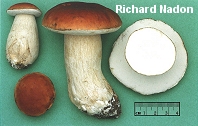| Major Groups > Boletes > Edulis Group > Boletus cf. edulis |

|
Boletus cf. edulis [ Basidiomycota > Boletales > Boletaceae > Boletus . . . ] by Michael Kuo No, "cf" doesn't stand for "chicken fried," even though I am writing this in the Midwest (where, for the uninitiated, we actually have a popular meal called "chicken fried steak"). It's a mycological convention that abbreviates a Latin verb for "compare" (conferre) Maybe it's Boletus edulis, the well-known, classic European species. Like the European mushroom, our eastern North American version has a tacky, bald cap—and, like the European species, it is usually found under spruces (especially Norway spruce, which is a European import), though it is occasionally found under other conifers or even hardwoods. The cap color, however, is consistently what I would call "orangish brown" or "cinnamon," while the European species is simply brown. For examples of the color difference, compare the photos and drawings here and on the Boletus edulis page. A throng of roughly similar North American species constitutes the North American Boletus edulis group , but most are fairly easily separated from the mushroom described here on the basis of geography and/or physical features.Description: Ecology: Mycorrhizal with conifers, especially spruces (especially Norway spruce), and, reportedly, occasionally with hardwoods; growing alone, scattered, or gregariously; summer and fall; distribution uncertain, but possibly limited to northeastern North America. In my area (central Illinois), I have never found the mushroom I am describing here; I have seen it only in Pennsylvania and in northern Michigan. The illustrated mushrooms are from Pennsylvania and Québec. Cap: 6–10 cm; convex in the button stage, becoming broadly convex to nearly flat; greasy to sticky when fresh; bald; light to dark orangish brown; often somewhat paler toward the margin. Pore Surface: Whitish and "stuffed" at first; becoming pale yellow and eventually olive yellow; not bruising; at maturity with 2–3 round pores per mm; tubes to 2 cm deep. Stem: 5–10 cm long; 2–3 cm thick; usually swollen and club-shaped when young, becoming club-shaped to more or less equal; finely reticulate over at least the upper portion; white to brownish areas. Flesh: White; firm; unchanging when sliced. Odor and Taste: Pleasant, but not distinctive. Chemical Reactions: Ammonia negative on cap surface; bluish, then purplish, then whitish with a purplish ring on flesh. KOH negative on cap surface; dull orange on flesh. Iron salts negative on cap surface; negative on flesh. Spore Print: Olive. Microscopic Features: Spores 12–19 x 4–5 µm; fusiform; smooth; ochraceous in KOH. Pleurocystidia 35–45 x 5–7.5 µm; narrowly fusoid-ventricose; hyaline; smooth; thin-walled; inconspicuous. Pileipellis an ixocutis with transitions to an ixotrichoderm; hyaline in KOH; elements 4–7.5 µm wide, smooth; exserted terminal cells subclavate or cylindric with rounded apices. REFERENCES: (Coker & Beers, 1943; Snell & Dick, 1970; Smith & Thiers, 1971; Grund & Harrison, 1976; Smith, Smith & Weber, 1981; Phillips, 1991/2005; Lincoff, 1992; Both, 1993; Barron, 1999; Roody, 2003; McNeil, 2006; Miller & Miller, 2006; Kuo, 2007.) Herb. Kuo 07221412. This site contains no information about the edibility or toxicity of mushrooms. |
© MushroomExpert.Com |
|
Cite this page as: Kuo, M. (2016, September). Boletus cf. edulis. Retrieved from the MushroomExpert.Com Web site: http://www.mushroomexpert.com/boletus_cf_edulis.html |






